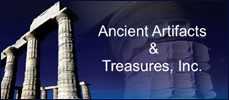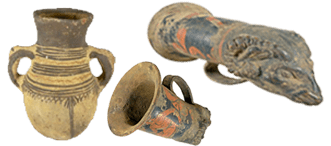Few things are more exciting than adding special pieces to a collection. Whether you collect artifacts, ancient coins, fossils, minerals, crystals or other antiquities from around the world, Ancient Artifacts & Treasures, Inc. has the inventory selection for you.
Collecting and Investing
By John McIntosh
Ancient Artifacts & Treasures, Inc.
80,000,000 B.C: A Tyrannosaurus rex missteps and finds itself mired in a sink hidden beneath the underbrush. Millions of years later, a paleontologist the skull. In 2016, the T-rex’s restored skull sells for the high price of $1.8 million.

On June 6, 2013 a mineral specimen of Rose Quartz hit a record high of $662,500 at auction. At the same auction, an aquamarine crystal sold for $158,500.
The “Ides Of March” Denarius, an ancient Roman silver coin struck by Brutus after assassinating Julius Caesar, sets a record price of $546,250.

These are all examples of the strange and wonderful world of collectibles. While there is no denying the thrill of owning a T-Rex skull or an Ides of March denarius, much cheaper collectibles will still give an owner the thrill of owning and displaying a nice collectible.
All That Glitters …
The reason we began by discussing a fossil, a mineral and coin is that people have no qualms about calling them collectibles. However, when you speak about diamonds, gold and other precious materials, people tend to call them investments. In theory, these materials – and even stocks – could be termed collectibles because their price is based more on what people are willing to pay for them (their market value) than on their actual intrinsic value. But in the practical world, precious metals have an intrinsic value.
They’re not liquid and no sure thing, but collectibles can be a profitable investment. Rare instruments, for example, have doubled in value during the past ten years, and vintage wristwatches have gone up by about 5% per year. In baseball card collecting the Honus Wagner is the holy grail; last year Arizona Diamondbacks owner Ken Kendrick paid a record $2.8 million for the highest-graded one in existence.
Minerals, in particular, are so hot that Dallas-based Heritage Auction Galleries created a new department for them in March and plans to hold two mineral-only auctions per year. The finest specimens of tourmaline, rhodochrosite and crystallized gold are fetching more than $1 million apiece—about five times what they sold for five years ago, Heritage says. (See “If Facebook Delivers (Or Disappoints), Try Minerals.” Forbes, May 18, 2012)
People collect for a variety of reasons besides making money: to achieve status (for instance, to be able to say they own the finest ancient coin); because they’re drawn to a particular type of item or genre of art; or out of a desire to own a piece of history or complete set (for example, by collecting every penny minted in the U.S.).
Collect What You Like
If you like an item, the chances are many others will also like it, and you get pleasure from it while you own it. Don’t try to time the market by investing on the basis of current fads or what you think will be the next hot item. Instead, collect for the long haul and collect what you like.
Still, that doesn’t mean you shouldn’t collect items you’re passionate about. Los Angeles urologist William Sloan, 70, is a lifelong amateur violinist. During the 1980s Sloan bought a Stradivarius for $400,000 and a Guarneri del Gesù for $300,000, financing most of the purchases with high-interest (about 13%) loans from a Toledo bank. He paid off the loans within a decade, and today those rare instruments together are worth more than $12 million.
Collecting can be an emotionally fulfilling hobby as well as a potentially lucrative investment. However, it is also an illiquid, very inefficient market with little regulation. Nowhere else does the phrase “buyer beware” seem more applicable. So, here are some tips that savvy art collectors know that you should keep in mind as you start to build your collection.
Buy with your Eyes, not your Ears
Buy what interests you and have a point of view. Some art buyers are so caught up in what they hear is hot that they are buying other people’s tastes and then end up living with works they don’t like that they can’t get rid of. Also, many better known collections have a theme or focus. Collectors with a point of view often become known and sought after for their collections.
Knowledge is Power
This may seem self-evident or at worst patronizing to say, but knowledge truly is power. Become an expert or at least knowledgeable enough to distinguish the fabulous from the fake. Try to learn from a pro who has no financial stake in helping you—say, another collector rather than a dealer.
If you can’t become an expert yourself, find one you trust to guide your purchases. Having a trusted expert, like an advisor, who works for you alone and not a gallery or auction house can help you make sense of the motivations of different players in the market place and of the prices.
Quality retains and often increases in value.
Savvy buyers understand that a brand name can only take you so far and seek out “best-in-kind,” meaning they’d rather own a top condition coin rather than the same coin in much worse condition.
Financial Rewards often accompany those who have invested emotionally in the process.
It’s like anything else in life: the more you put in, the more you get in return. Spend the time and do your homework, seek out experts, understand the market place, don’t get caught up in trends and you will build a collection that is both emotionally and financially rewarding.
Here at Ancient Artifacts & Treasures Inc., we have the both the knowledge and the items to help you in your collecting and investing.



Comments are closed.